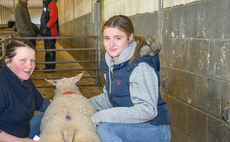
Following its preview in September 2017 and its big UK reveal at the following 2018 Lamma show, we finally get our hands on Fendt's new Vario MT tracked tractor for a test drive.
Taking on Agco's tracked tractor baton for Europe, Fendt's introduction of tracked tractors picks up from where the Challenger brand left off.
As reported, Agco decided to pull the plug on the Challenger brand in Europe and absorb all its products into the Bavarian brand.
As well as the tractors, this also includes sprayers, automatically giving Fendt a larger portfolio of equipment and an alternative to its wheeled tractors in the process.
As in the Challenger days, Fendt's line-up of tracked tractors includes seven models; three small framed machines from 380 to 431hp and four large framed machines from 492 to 646hp, with all models built in Agco's Jackson plant, Minnesota, US.
Changes
But aside from a fresh paint job, what has Agco done to Fendt-ise the tractors, if anything?
In the case of the larger models, it is just that, a paint job - sticking with the same engine, track units and gearbox.
But for the three smaller machines it is an entirely different story, which sees all the tractor's key areas receive attention.
To find out what impact these updates have on the tractor, we try out the largest of the small framed machines, the 943 Vario MT, hitched to Amazone's latest six-metre Ceus disc/tine cultivator.
TRANSMISSION
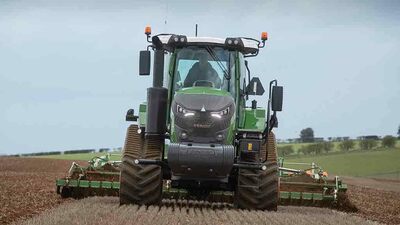
ONE of Fendt's major contributions to the American-built machine is the introduction of its VarioDrive continuously variable transmission (CVT).
Based on the CVT developed for the wheeled 1000 Series, it uses the same internal pump and motors, but is configured to suit a tracked tractor.
As a result, the transmission effectively works through three blended stages which sees various mixes of hydraulic and mechanical power transfer.
Below 8kph, both hydrostatic motors work together to offer full power transfer.
Roughly between 8kph and 20kph, one of the motors gradually closes down, as an element of mechanical transfer takes over.
Above 20kph, a clutch disconnects the power outputs of the two motors to avoid parasitic losses - the same clutch which is used on the 1000 Series to engage mechanical four-wheel drive.
Finally, at a top speed of 40kph, both motors give way to full mechanical power transfer.
Impact
Like the 1000 Series, there are no range changes to make, offering seamless speed changes from 0-40kph. Apart from a slight change in transmission tone, it is practically imperceptible as to what the transmission is doing.
In terms of what impact a CVT has on this tractor, it is substantial.
No longer do you have to clunk up and down a powershift; you do not have to manage the revs and ratios; you are always at the right speed; it is smoother on the tractor, operator and implement; and, like it or not, it takes less skill to get the most out of the tractor.
In addition, a clever differential steering system has also been created specifically for this tractor.
Using a bi-directional hydraulic pump, it allows automatic steering systems, for example, to be directly integrated.
As before, this enables a ‘virtual' differential lock feature.
TRACK UNITS
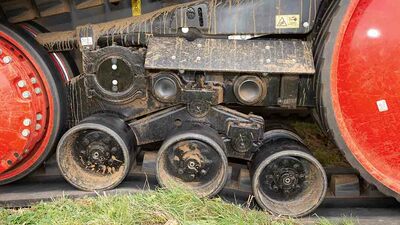
THOUGH they look similar from a distance, both the Challenger's track units and undercarriage have had a substantial re-design.
Primarily driven by improving comfort and ride quality, the updates are also said to improve traction. To this end, the wheelbase has been extended by 127mm to 2,565mm, offering a larger contact area and, therefore, better power transfer and less compaction.
In all, when fitted with 762mm belts, the total contact patch for both belts is 3.9sq.m. When ballasted up to 16 tonnes, this equates to approximately 400-500g/sq.cm, or equivalent to 0.4-0.5 bar, based on a static calculation.
Belts
Our test machine was fitted with the popular 762mm belts. As an option, narrower 635mm or wider 864mm tracks can be specified, the latter not so popular due to their wide transport width.
Within the track units, major work has seen much improvement to the mid-roller assembly.
Particularly in the area directly under the driver, the development to the mid-roller's frame allows a greater range of movement, reducing vertical shock loads. In addition, the ability to hug the ground better should see an improvement in grip.
Designed to reduce heat buildup and wear, mid-rollers are larger.
Now up to 380mm in diameter, it means their rotation speed is less. In addition, to prevent wear a plastic ring runs between the mid-rollers and the belt's central tread blocks.
ENGINE
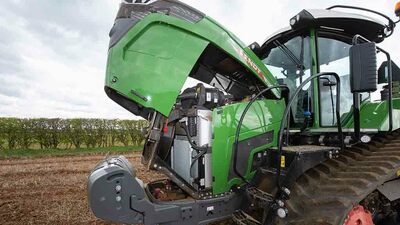
LIKE Fendt's 1000 Series wheeled tractors, the 900 MT's engine is tuned to match the Vario transmission, which sees it adopt a low revving concept topping out at 1,700rpm and achieving peak torque between 1,200 and 1,600rpm.
However, unlike the 1000 Series which uses a MAN engine, the 900 MTs stick with the seven-cylinder Agco Power motor inherited from the tracked tractor's predecessor.
As some may remember, not fondly, this engine did suffer a few reliability issues in its former Challenger life.
To alleviate any concerns, Agco has been busy developing the motor which includes more vertical block supports, updated pistons and improved piston cooling. Revving lower is also said to help its cause.
Working with the Vario transmission, it means the most can be made of the engine's performance, with the transmission adapting to changing conditions.
In our fairly light brash soil conditions, working at 250mm deep, the tractor happily cruised away at about 13kph at 15-1,600rpm. Average fuel use was 14.4 litres per hectare.
On the road too, top speed can easily be achieved at 1,650rpm, and more often than not reached at 1,500rpm.
Radiators
Inherited from the 1000 Series is the push-type cooling system which sees air forced into the radiators at an angle from in front and above the tractor.
This is said to avoid any dirty or obstructed air into the radiators, while creating a cooler and denser airflow.
However, unlike the 1000 Series, it gets its own oil reservoir for the hydraulic fan drive. This allows ‘on-demand' cooling and the ability to automatically reverse the fan as and when the tractor needs it.
UNDERCARRIAGE
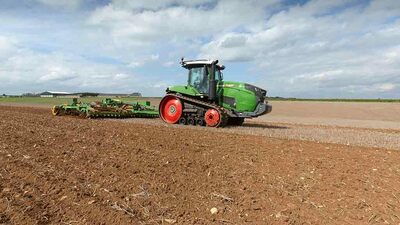
RUNNING between the two track units, the ‘hard bar', from which the track units get their suspension, has now been moved 130mm further forward, increasing front axle travel.
Previously, the hard bar relied on Challenger's rubber block ‘marshmallow' system.
While this did a reasonable job, suspension performance has been improved dramatically with the introduction of coil springs and dampeners.
They are effective too, just by leaning on the front of the tractor, you can see the suspension work.
Depending on track width settings, front axle movement can be up to +/-200mm.
Though it is hard to tell if the track unit and undercarriage improvements increase traction, the improvement in ride quality is definitely noticeable, and welcome. The see-saw effect has definitely been reduced.
Track widths (from the belt centres) can be adjusted from 1,829mm to 2,235mm.
At the maximum track width setting, 11 degrees of track unit oscillation is achievable.
Weight
Because of the redesigned undercarriage and track units, the tractor has evolved into a slightly heavier beast. Now 15.5 tonnes without ballast, its natural weight means there is no need for the option to add wafer weights along the length of the running gear.
Ballast can, however, still be added to the front idlers or the nose to make 20.9t gross weight.
CAB AND CONTROLS
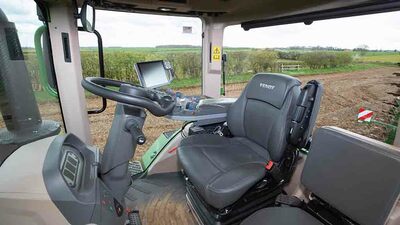
UP-TOP and the Vario MT sticks with the old Challenger cab frame.
Inside though, a sprinkle of Marktoberdorf magic sees a familiar Fendt environment introduced, including dash, right-hand console and terminal.
In terms of controls and operation, it drives just like any other Fendt, with the ability to alter speed by either the ‘stick or pedal.
At the moment, the tractor is only available with the firm's ‘simple' joystick, with its higherspec Profi version to come later this year. This will allow further functions to be controlled.
Auto-park brake is a feature, which kicks in eight seconds after coming to a stop, or as soon as the operator leaves the seat. It disengages as soon as the travel pedal or ‘stick is used to move off again.
When the handbrake is engaged, the engine will automatically idle down to 800rpm.
In addition to the extra comfort gained by the track unit and undercarriage modifications, two new cab suspension systems have also been developed.
Dampeners
As standard, rubber blocks in each corner have been engineered to absorb bumps, or for extra comfort, two rear dampeners can be specified, as our machine had.
Overall, both systems are simple and effective.
As for in-cab noise, our early production model test machine did have a large amount of hydraulic whine coming from the steering system, but the manufacturer assures us this has been cured for full production models.
FG VERDICT
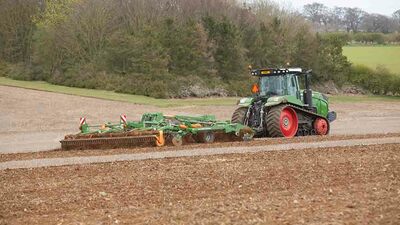
UNDER the Fendt brand, the developments Agco has made to the tractor since its Challenger days are immediately noticeable.
Particularly the track units and undercarriage, ride quality is much improved, and as such traction should also benefit.
In addition, the transmission plays a big part in transforming the way the tractor operates, which in turn makes it much easier to drive.
Reliability
Though probably cured, there still hangs a question mark over the seven-cylinder's reliability and, for the sake of customers' sanity, we do hope the in-cab noise issues have been sorted.
So far, the signs are good, with early models clocking up nearly 2,000 hours without a hitch. The question now is, what will Fendt do with the large framed tracked tractors?
























